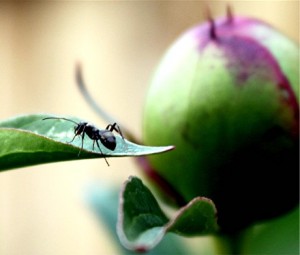Aspiring gardeners everywhere converge on flower shops during Memorial Day weekend to populate yard and house with perennials, bushes, and baskets. This tradition always reminds me of a lesson I learned growing up. My mom is a fantastic gardener with a vast array of knowledge about the little known intricacies of plants. When I was young she shared the story of an often overlooked symbiotic relationship: the ant and the flower.
The peony is a long-stemmed perennial with lush, green foliage and an oversized, fragrant blossom. It’s the supernova of flowers with a tightly confined bud that bursts open to reveal free form, vibrant petals in full bloom.
I rarely see this flower featured in vases, centerpieces, or clipping gardens, and with good reason. Its indoor unpopularity can be attributed to the transportation of an unwelcome house guest: the ant.
When the peony is in its constricted bud form, the ant is drawn to its sticky, sweet sap. The ant will journey to the center of the bud, loosening the petals as it squeezes in between, pushing its way to the sweet nectar. Over time, some believe it is the ant’s journey inward to the nectar that opens the petals, exposing them to the sunlight and completing the transformation from bud to bloom. Once the flower blooms, the ant leaves.
Without the ant, full bloom is unlikely. The internal petals are shrouded by the constricting outer ones, and sunlight is prevented, leading to browned and shriveled buds that drop from the stem.
Some say this is merely a tale–ants aren’t essential for the transformation to occur. All agree, however, that if the ants weren’t there, other bugs would eat away at the plant, thereby killing it.
There’s a symbiotic relationship between our past and present. If the bud to flower transformation is growth, the ant is the past nudging its way into the center of that bud, intrusively pushing until it opens. Once the transformation is complete, it leaves.
Most of us dissect time into separate blocks. We say, “It’s in the past,” meaning that what happened at a single point in our life story no longer affects the way we interact with our current reality.
We have a greater propensity to believe this when we’re in pain. This is a protective mechanism. If we tell ourselves an experience is in the past and no longer applies to our present, we can suppress the painful feelings and associations that go with it.
The past is the intrusive ant, imposing upon the present flower. Without the present, the past remains untranslated; without the past, the present remains underdeveloped.
All of us have negative, patterned responses that insist on surfacing, episodically. This can come in the form of hair trigger reactions to yelling, or compulsive nail biting when we’re under stress, or over indulging in our hobbies when we’re angry.
These responses are markers of our past bleeding into our present. They represent the way we’ve learned to compensate. Most of us blindly engage in these responses with little thought to how they originated until they become untenable.
If we choose to notice them, they are clues to understanding that symbiotic relationship, and how the translation of the past can transform the present.
This Memorial Day weekend, when you observe the blossoming spring foliage, consider the ant and the flower. What are the responses in your world that are markers of the intruding past? What is unfinished in the growth process that necessitates the symbiosis?
As I write this, there’s a tiny, black ant dancing across my keyboard. I feel a little surge of excitement, as if he’s a welcome herald, signaling that my life is about to change.


I so appreciate this post Amy. The symbiotic connection of past to present just makes sense. I watched the movie Saving Mr. Banks last night with my girls. In this movie the very concept of past infiltrating present behaviors is seen as the character played by Emma Thompson wrestles with her very painful past and we see flashbacks to all her deeply established habits in the present. It was well done and your post is timely to reinforce the ideas presented. Good insight for us all to consider personally.
Have a great Memorial Day holiday!
Karen, Thanks for your comments. That movie is a great illustration of the symbiosis. Once we name it, it’s amazing how often we see that cycle play out in the world around us. I also hope you had a lovely Memorial Day weekend.
I love analogies from the natural world. My daughter just received a peonie plant for her to grow in our garden. It is potted now, and when my fourteen year old beauty received the young plant she was very happy to have one of her own. She responded by realizing that it probably won’t bloom until next year. A day later she was irritated before school and began pleading with me to have someone come out to get rid of the ants in my kitchen.
I do know that the phrase “just put your past behind you” is fruitless and not God’s will for our lives. Thanks Amy for your insight this week.
Melanie, thanks for your comment. It sounds like it was one of those great parenting opportunities and something your daughter will remember for a long time. I also love how nature is teeming with meaningful metaphors.